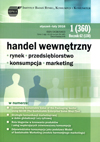Ocena preferencji konsumentów związanych z wyborem dziczyzny
Evaluation of Consumers’ Preferences Related to the Choice of Game Meat
Author(s): Katarzyna Kwiecińska, Małgorzata Kosicka-Gębska, Jerzy GębskiSubject(s): National Economy, Health and medicine and law, Socio-Economic Research
Published by: Instytut Badań Rynku, Konsumpcji i Koniunktur
Keywords: game meat; consumer; consumption; choice factors;
Summary/Abstract: The basic aim of considerations is to learn consumers’ preferences towards game meat taking into account the evaluation of frequency and amount of consumption thereof as well as the important factors determining the process of making decision on consumption or non-consumption thereof. The obtained results may be a valuable source of information for the Konsorcjum Dziczyzna Polska (Consortium Game Meat Poland) established on the initiative of the Polski Związek Łowiecki (PZŁ) [Polish Hunting Association] whose basic aim is to promote the knowledge of values of game meat and the possibilities to prepare meals therefrom. To achieve the undertaken research objective, the authors used the quantitative nation-wide research conducted in 2012 addressed to 1000 adult inhabitants of Poland declaring they were meat consumers. Of that research sample, only 256 respondents are the consumers who in the last two years at least once had consumed game meat. Within the framework of the statistical analysis of data, there was applied the frequency analysis, the descriptive statistics and contingency tables. For the purpose of ascertainment of the statistically significant differences between variables, there was used the Pearson’s chi-squared test. In their article, the authors hypothesised that Polish consumers did not consume game meat primarily for fears connected with the possibility to get animal disease infection such as trichinosis. The analysis of the collected data confirmed that, first of all, consumers consume for its flavour and tenderness. The respondents are afraid of foodborne diseases in case of game meat, though, at the same time, almost one half of the body of respondents assess that they currently consume it too little and express their readiness to eat more dishes and products made of game meaty in the future.
Journal: Handel Wewnętrzny
- Issue Year: 360/2016
- Issue No: 1
- Page Range: 53-64
- Page Count: 12
- Language: Polish

